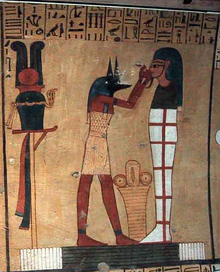User:Bag0hchipz/Ancient Egyptian Relgion
Ancient Egyptian Religion
[edit]Ancient Egypt intertwined beliefs and practices throughout their civilization. From their growth within their society the understanding and sharing of values through religion helped exponentially. Throughout the years of this peculiar civilization the differences between their culture along with the higher sense of individuality was personified through their polytheistic religion which began in the late prehistoric period when writing was being invented along with myths being created. Religion played a key role within Ancient Egyptian society which intertwined with mythology, science, medicine, psychiatry, magic, spiritualism, her biology, religion and the afterlife[1] .
Religion
[edit]Within their religion, gods were the creators of humans and were seen as higher power, like kings or queens which created order and guidance to those who follow or are in their society. Although, the civilization grew exponentially beyond their time, a higher sense of individuality and emphasis in manifesting their personalized form by their beliefs and folklore through their mythical dieties[2]. There was an ever eternal journey in one’s life on Earth upon Egyptian religion which played a daily role upon their lives. The underlining religion and principle upon Egypt was known as heka (magic) revolving around one god which personified the communication between human beings and gods through magic and medicine. Through religion, there were institutions set in place with the main components of theological aspects along with how to follow the rituals along with the stories that have grown over time about their deities, to the morality and laws to abide by.
Gods and Goddesses
[edit]
With Heka, comes the honoring harmony between life, death and the continuance of life after death if one was worthy, through the principle of ma’at (harmony). This goddess ma’at holds the white feather upon a weights to have the decision of ones life after death. By honoring and following harmony, Osiris, The Lord of the Dead welcomes judgment and assures this process as welcoming the dead to the Hall of Truth. Overcoming judgment, the power of love and overcoming death represents Isis, the sister of Osiris who helped bring him back to life along with saving her own son Horus from certain death. Horus in resemblance with a falcon, was perceived as above all or from a distance due to being the eyes of the sun and move and embodies the cosmic heavens. From life, comes death, following Anubis, the jackal-headed deity in the embalming process to help pertain the dead kings/pharaohs to pass and transform after death. This process of embalming were beyond their time, and similar to the process that is to this day[2].
Culture and Traditions
[edit]
From the start, their obsession with religion was a daily aspect of ancient Egyptian culture and traditions. Their pharaohs were idolized by being brought down from the cosmic heavens to help be the entity to connect civilians to the deities, visa versa. Although, this hierarchal monarch system was rigorous through slave labor, due to the vast importance in the transformation and transition past the after life, their process and daily lives, were radical to the peculiar system, from pharaohs, higher priests, along with a government that grew over the centuries. They came accustom to natural resources such as gold, limestone, and textiles along with paint that have lasted years. Their lives obtained cultural celebrations, rituals and building long standing tombstones, and palaces that show what was important and what was done on a daily basis[3].
Gender and Religion
[edit]
Although, there’s not a finite answer, between equality within genders from this civilization due to the remnants of its pass, there’s analyzation and time that suggests the equality between the genders, throughout their society along with religious background. Throughout the folklore or mythical historical background that’s left to transcribe, female and male deities are displayed to have an equal role from their rituals, spirituality along with their culture. There were primary roles, along with pictures images that there was an importance with this gender in a meaningful way and participated in society beside males; such as partaking in order, becoming priestess and providing music and rituals in the real world to being the basis throughout the start of birth spiritually, being the path to acknowledge who will go forth thorough the cosmos and rebirth, and death. They were always a part of daily lives and rituals[4].
References
[edit]- Bunce, Vicki. "LibGuides: Ancient Egypt: Life in Ancient Egypt". libguides.stalbanssc.vic.edu.au. Retrieved 2022-10-27.
- Cline, Eric H. (1996-01-01). "Chronicle of the Pharaohs: The Reign-by-Reign Record of the Rulers and Dynasties of Ancient Egypt. By Peter A. Clayton". American Journal of Archaeology. 100 (1): 196–197. doi:10.2307/506329. ISSN 0002-9114.
- "Cultures & Traditions - Art for the Afterlife - DMA Collection Online". collections.dma.org.
- "Egyptian civilization - Religion". www.historymuseum.ca. Retrieved 2022-10-17.
- Mark, Joshua J. "Ancient Egyptian Religion". World History Encyclopedia. Retrieved 2022-10-17.
- Onstine, Suzanne (2010-01). "Gender and the Religion of Ancient Egypt: Gender and the Religion of Ancient Egypt". Religion Compass. 4 (1): 1–11. doi:10.1111/j.1749-8171.2009.00178.
- Zucconi, Laura M. (2007-01). "Medicine and Religion in Ancient Egypt: Medicine and Religion in Ancient Egypt". Religion Compass. 1 (1): 26–37. doi:10.1111/j.1749-8171.2006.00004..
- ^ "Cultures & Traditions - Ancient Egyptian Beliefs - DMA Collection Online". collections.dma.org. Retrieved 2022-10-27.
- ^ a b "Egyptian civilization - Religion - Gods and goddesses". www.historymuseum.ca. Retrieved 2022-10-27.
- ^ Bunce, Vicki. "LibGuides: Ancient Egypt: Life in Ancient Egypt". libguides.stalbanssc.vic.edu.au. Retrieved 2022-10-27.
- ^ Onstine, Suzanne (2010-01). "Gender and the Religion of Ancient Egypt: Gender and the Religion of Ancient Egypt". Religion Compass. 4 (1): 1–11. doi:10.1111/j.1749-8171.2009.00178.x.
{{cite journal}}: Check date values in:|date=(help)
